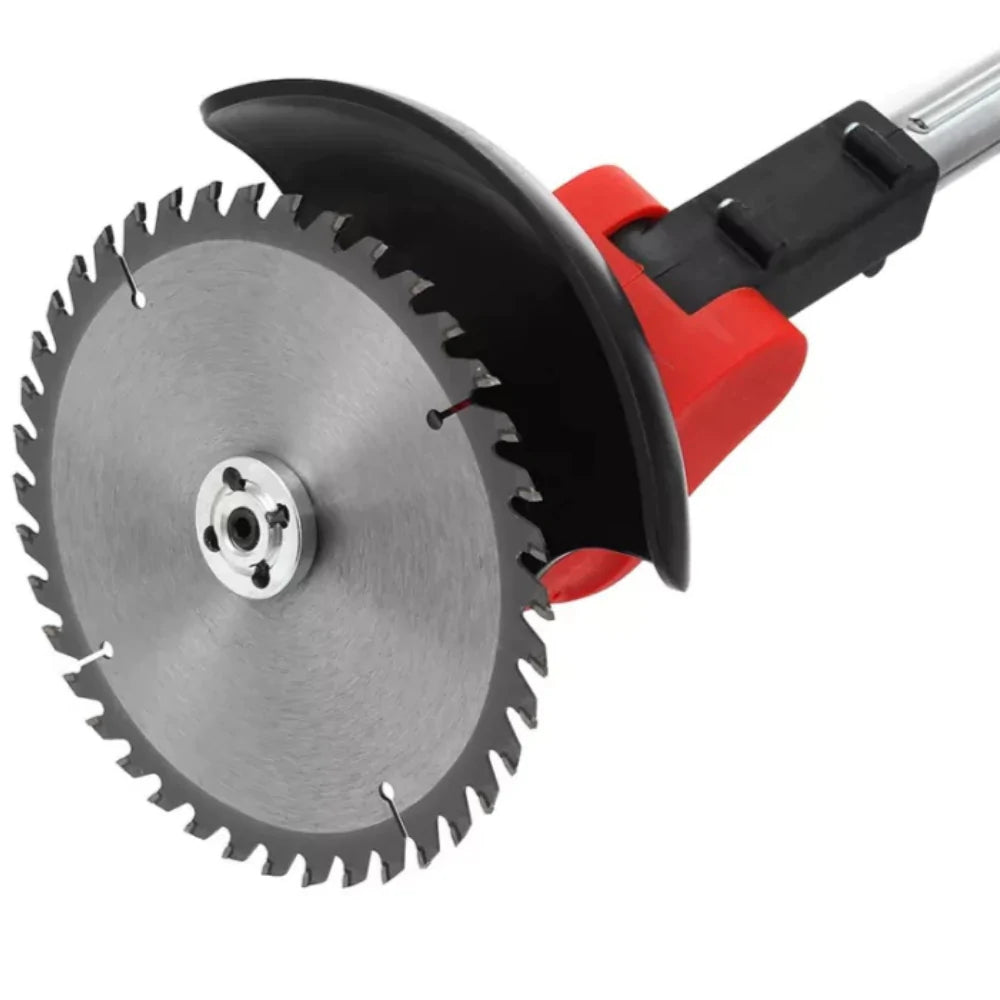Why is a Grass Trimmer Essential?
Grass trimmers are indispensable tools for anyone striving to maintain a beautiful lawn. They simplify the task of cutting tall grass and weeds to the desired height, eliminating the need for laborious manual shearing. Moreover, they excel in reaching areas inaccessible to lawnmowers, such as tight corners, along walls, and around intricate flowerbeds. Their handheld design allows for agility and multi-directional movement, making them versatile and efficient. A reliable grass trimmer quickly becomes a favorite gardening companion, streamlining tasks and enhancing the overall maintenance of your outdoor space. High-quality trimmers can significantly improve the appearance of your lawn, preparing it for mowing or preventing long grass from clogging your lawnmower.
Where Can Grass Trimmers Be Utilized?
Grass trimmers find utility in a wide range of settings, and different models cater to specific needs and durations of use. While there are no strict limitations on where you can use a trimmer, certain models may be better suited for particular outdoor spaces. Whether you have a small garden, a spacious lawn, or vast fields, there's a trimmer suitable for your environment.

What Are the Advantages of Grass Trimmers?
Understanding the pros and cons of each type of grass trimmer is crucial to ensure you make a choice that aligns with your preferences and requirements. Each type offers distinct advantages, enabling you to make an informed decision and achieve your gardening goals. Factors such as power source, weight, handling, and special features come into play. For instance, some trimmers excel at cutting through dense vegetation, while others prioritize quiet operation and user-friendliness.
How Do Grass Trimmers Differ?
With a plethora of options available, it can be overwhelming to begin your search for the perfect trimmer. This is especially challenging for those new to gardening and landscaping. To help you make an informed choice, let's delve into the details of each trimmer type and their respective benefits:
Electric Shears:
Electric grass trimmers are a popular choice among many gardeners. They rely on electricity for power and must remain plugged in during use, limiting their range to the cord's length. While electric trimmers are best suited for small to medium-sized gardens and offer ease of use, maneuverability, and low maintenance, their primary drawback is the cord length. They may struggle with thicker vegetation compared to gasoline trimmers.
Cordless Trimmers:
Cordless grass trimmers offer unparalleled freedom by operating on rechargeable batteries, often featuring advanced lithium-ion technology for extended runtimes. Consider the battery's projected runtime to ensure it meets your needs. Some models even allow you to use multiple batteries for uninterrupted operation. Cordless trimmers are ideal for larger gardens and complex lawns, offering flexibility without the constraints of cords.
Gas-Powered Trimmers:
Gasoline grass trimmers excel in tackling long, dense, and stubborn vegetation over extended periods. Professionals often prefer them due to their robust engines. They are entirely portable, cordless, and come in various sizes and power levels. The choice should align with the specific tasks you intend to tackle. Keep in mind that gasoline trimmers tend to be noisier and emit a strong petrol odor.
Types of Blades:
Another crucial consideration is the type of blades a trimmer uses. Different types of blades are suitable for various cutting tasks. Nylon line is common and suitable for trimming long grass and light vegetation using spinning motions. Metal brush cutter blades are more robust and can handle dense vegetation. It's essential to check if a trimmer allows for blade changes if you anticipate needing this feature in the future.
How to Choose Your Grass Trimmer:
Begin by determining the most suitable power source for your needs, considering factors like space, fuel availability, and required mobility. Once you've narrowed down the power source, delve into the specifications of each trimmer type. Carefully assess factors such as weight, size, and engine power to eliminate options that don't meet your specific requirements. Revisit your initial needs and objectives to avoid getting distracted by unnecessary features.
Lastly, read reviews from previous customers to gain insights into real-world experiences and gather feedback on the pros and cons of different trimmers. This valuable information can help you make an informed choice, ensuring you are satisfied with your selection and its performance over time and in various settings.
Why is a Grass Trimmer Essential?
A grass trimmer is an indispensable tool for anyone looking to maintain a well-kept lawn or outdoor space. These versatile devices simplify the task of cutting down tall grass and weeds to the desired height, eliminating the need for arduous manual shearing. Moreover, they excel at reaching areas that are inaccessible to conventional lawnmowers, such as tight corners, along walls, and around intricate flowerbeds. Their handheld design allows for agility and multi-directional movement, making them incredibly versatile and efficient. A reliable grass trimmer quickly becomes a favorite gardening companion, streamlining tasks and enhancing the overall aesthetics of your outdoor space. High-quality trimmers can significantly improve the appearance of your lawn, preparing it for mowing or preventing long grass from clogging your lawnmower.
Where Can Grass Trimmers Be Utilized?
Grass trimmers find utility in a wide range of settings, and different models cater to specific needs and usage durations. While there are no strict limitations on where you can use a trimmer, certain models may be better suited for particular outdoor spaces. Whether you have a small garden, a spacious lawn, or vast fields, there's a trimmer suitable for your environment.
What Are the Advantages of Grass Trimmers?
Understanding the pros and cons of each type of grass trimmer is crucial to ensure you make a choice that aligns with your preferences and requirements. Each type offers distinct advantages, enabling you to make an informed decision and achieve your gardening goals. Factors such as power source, weight, handling, and special features come into play. For instance, some trimmers excel at cutting through dense vegetation, while others prioritize quiet operation and user-friendliness.
How Do Grass Trimmers Differ?
With a plethora of options available, it can be overwhelming to begin your search for the perfect trimmer. This is especially challenging for those new to gardening and landscaping. To help you make an informed choice, let's delve into the details of each trimmer type and their respective benefits:
Electric Shears:
Electric grass trimmers are a popular choice among many gardeners. They rely on electricity for power and must remain plugged in during use, limiting their range to the cord's length. While electric trimmers are best suited for small to medium-sized gardens and offer ease of use, maneuverability, and low maintenance, their primary drawback is the cord length. They may struggle with thicker vegetation compared to gasoline trimmers.
Cordless grass trimmers offer unparalleled freedom by operating on rechargeable batteries, often featuring advanced lithium-ion technology for extended runtimes. Consider the battery's projected runtime to ensure it meets your needs. Some models even allow you to use multiple batteries for uninterrupted operation. Cordless trimmers are ideal for larger gardens and complex lawns, offering flexibility without the constraints of cords.
Gas-Powered Trimmers:
Gasoline grass trimmers excel in tackling long, dense, and stubborn vegetation over extended periods. Professionals often prefer them due to their robust engines. They are entirely portable, cordless, and come in various sizes and power levels. The choice should align with the specific tasks you intend to tackle. Keep in mind that gasoline trimmers tend to be noisier and emit a strong petrol odor.
Types of Blades:
Another crucial consideration is the type of blades a trimmer uses. Different types of blades are suitable for various cutting tasks. Nylon line is common and suitable for trimming long grass and light vegetation using spinning motions. Metal brush cutter blades are more robust and can handle dense vegetation. It's essential to check if a trimmer allows for blade changes if you anticipate needing this feature in the future.
How to Choose Your Grass Trimmer:
Begin by determining the most suitable power source for your needs, considering factors like space, fuel availability, and required mobility. Once you've narrowed down the power source, delve into the specifications of each trimmer type. Carefully assess factors such as weight, size, and engine power to eliminate options that don't meet your specific requirements. Revisit your initial needs and objectives to avoid getting distracted by unnecessary features.
Lastly, read reviews from previous customers to gain insights into real-world experiences and gather feedback on the pros and cons of different trimmers. This valuable information can help you make an informed choice, ensuring you are satisfied with your selection and its performance over time and in various settings.








